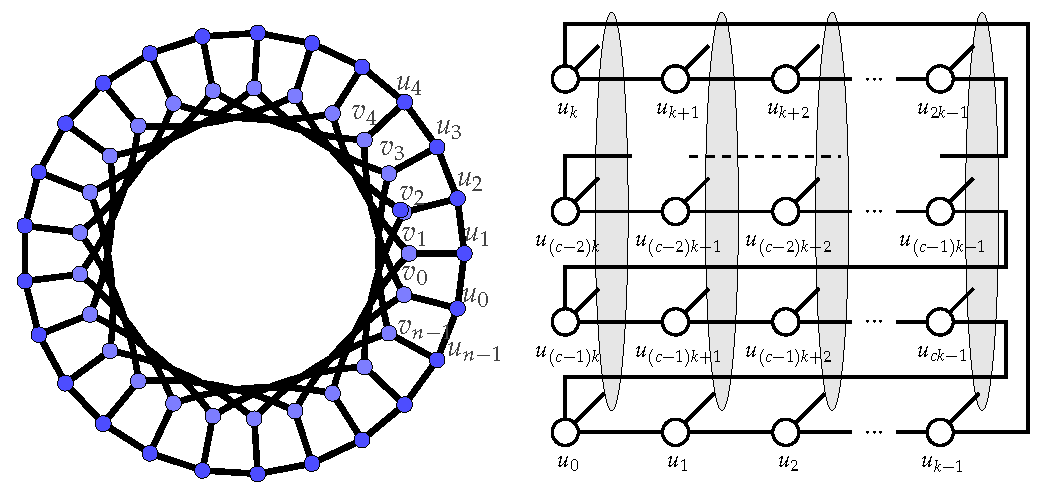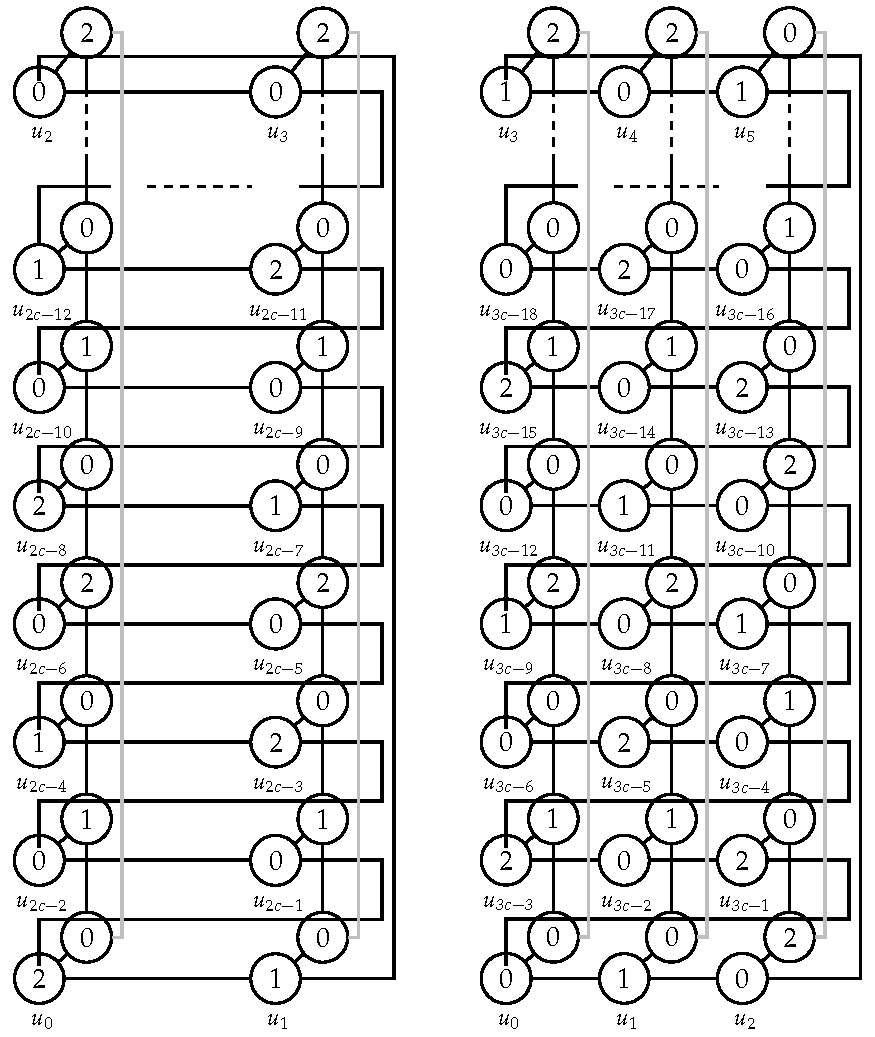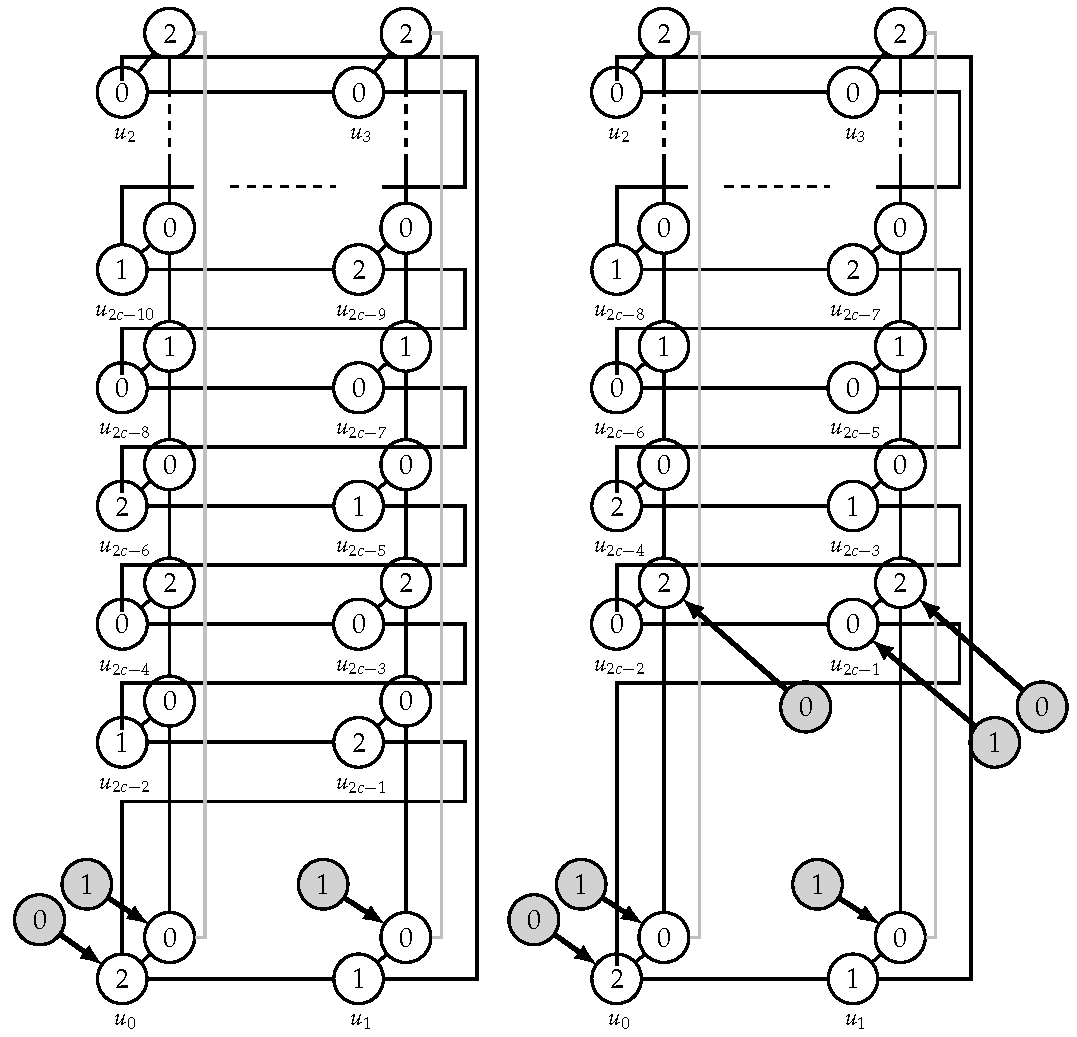On 2-Rainbow Domination of Generalized Petersen Graphs P(ck,k)
Abstract
1. Introduction
2. Preliminaries
2.1. Generalized Petersen Graphs
2.2. Rainbow Domination
3. Related Previous Work
- (1)
- Exactly one vertex of receives color 1 and exactly one vertex receives color 2;
- (2)
- The two vertices on the cycle that receive colors are not adjacent;
- (3)
- Exactly one vertex of receives color 1 and exactly one vertex receives color 2;
- (4)
- Assume (wlog) and . Then and .
- Start with .
- Delete verticesandand delete all edges incident to these vertices.
- Add edges on the inner cycles and edge on the outer cycle.
- Start with . Choose . Delete the vertices and vertices of the corresponding inner cycle and delete all edges incident to these vertices.
- Add edges for .
4. Summary of Our Results
5. 2RD Coloring of , , and
6. The Case with Exact Answer
7. Towards an Improved Lower Bound
- (i)
- For each vertex v of G, or 1.
- (ii)
- The set of the colored vertices is independent.
- (iii)
- If then exactly two neighbors of v are colored (with distinct colors).
- (1)
- Exactly h vertices of receive color 1 and exactly h vertices receive color 2;
- (2)
- Exactly h vertices of receive color 1 and exactly h vertices receive color 2;
- (3)
- Assume (wlog) and . Then and .
- Case (a). Let us first suppose that the number of colors of the vertices from is at most . Then there exists a path such that at most one of the vertices is colored and it is colored with exactly one color, by Observation 1(i). Since the coloring is proper, the only possibility is that is colored and all of the other vertices on have no color. Let be the corresponding set of vertices , where . It follows from Observation 1(ii) and from the definition of a proper coloring that is the only vertex without color and each of the remaining vertices must be colored. Now let us consider the set of vertices (, where . By definition of a proper coloring, one of the neighboring vertices of a vertex that lies in or is colored. W.l.o.g. assume that is colored. Moreover, by Observation 1(ii) the vertices should have no color. Finally, let us consider the path (, where . Since is colored, by Observation 1(ii) should have no color. Additionally, by Observation 1(iii) there is exactly one of the vertices and that is colored; w.l.o.g. let be such a vertex. However, then is not colored and has two non-colored neighbors ( and ), which is a contradiction to Observation 1(iii).
- Case (b). Suppose now that the number of colors of the vertices from is at least . Then there exists a path such that at least three among the vertices are colored (note that, by Observation 1(i), each of them is colored with exactly one color). By Observation 1(ii), the only possibility is that , and are colored (and the vertices and are non-colored). We will use the same idea as before to define the sets , , and , namely choose such that . Similarly, and are determined by and . Then, by Observation 1(ii) and (iii), all the vertices are not colored. Since is colored with exactly one color, by Observation 1(ii) there is exactly one neighbor of that lies in or and is colored with exactly one color. W.l.o.g. assume that is such a vertex. Then by Observation 1(ii) is not colored. Since the vertices and are not colored, must be colored, by Observation 1(iii). By the same reasoning, because and are not colored, has to be colored. Therefore, by Observation 1(ii), the vertices and are non-colored vertices. However, then is not colored and has two non-colored neighbors (and the one of the neighbors is colored with exactly one color), which is a contradiction to the fact that the coloring is proper.
- At last, we can suppose that there are exactly colored vertices of and the number of colors of one color class exceeds the number of the colors of the other color class. Then, there exists a path P on 5 vertices in where at least two of the vertices are colored with the same color. By the same arguments as before, we conclude that those two vertices are the only colored vertices on P. Since the coloring is proper and since Observation 1(i) holds, there are no three consecutive vertices on P that are not colored. Moreover by Observation 1(ii) those two colored vertices are not adjacent. The first possibility then is that those two vertices are at distance 2. However, this is a contradiction to fact (iii) from Observation 1. The second possibility is that those two vertices are at distance 3. We denote those two colored vertices by and . Moreover, we denote by the sequence of the colored vertices of , traversing along cycle . Moreover, let be the sequence of the distances between the colored vertices of . One can easily check that (note that the distance , since ). Now, by applying Observation 1(iii) every pair of colored vertices, that are at distance 2, should be colored with different colors. Therefore there are exactly h vertices of one color and h vertices of the other color, which is a contradiction to the assumption that the number of colors of one color class exceeds the number of the colors of the other color class.
- By the previous arguments, we conclude that must include exactly h vertices of color 1 and exactly h vertices of color 2 (which confirms statement (1)).
- Case (c). The coloring of any discussed above implies that, in each , at least h vertices must be colored with color 1 and at least h vertices must be colored with color 2. On the other hand, observe that the union of induces the outer cycle of length and that, by the same arguments as above, we know that the total number of colored vertices on the outer cycle must be and both colors must be used evenly. Hence, in each , exactly h vertices must be colored with color 1 and exactly h vertices must be colored with color 2.
- (3) Moreover, the second part of statement (2) determines the two possible specific orders of colors for vertices in . Again, we denote by the sequence of the colored vertices of , traversing along the cycle . First, assume that w.l.o.g. , , , , …, and (note that such a coloring is proper only for , and, therefore, and holds). In such case it is an exercise to see that the colors of the vertices from the sets and are uniquely determined by the colors of and that for an arbitrarily chosen the obtained coloring is not proper.
- Secondly, let us assume that w.l.o.g. and . Then is colored with and , while must have a neighbor of color 2 outside and must have a neighbor of color 1 outside . By the same reasoning one can observe that and (which confirms statement (3)).
8. Upper Bounds by Constructions
- (a)
- If then alter , for .If , i.e., if at least two rows were deleted, then also let , for .
- (b)
- If , let and for .If , then also let for .
- (c)
- Finally, if , and , set .
9. Better Upper Bounds by Constructions
10. Conclusions and Ideas for Future Work
- Characterized all for which the lower bound is obtained. In these cases, the 2-rainbow domination number is known.
- For all other cases, we provide lower and upper bounds with small gaps. In these cases, it remains open to find exact values, at least for some subfamilies.
- Can the bounds of Theorem 4 be improved for the rainbow domination number?
- Can the bounds of Theorem 4 be improved for the singleton rainbow domination number?
Author Contributions
Funding
Data Availability Statement
Conflicts of Interest
References
- Brešar, B.; Henning, M.A.; Rall, D.F. Rainbow domination in graphs. Taiwan J. Math. 2008, 12, 213–225. [Google Scholar] [CrossRef]
- Vizing, V.G. The Cartesian product of graphs. Vycisl. Sist. 1963, 9, 30–43. [Google Scholar]
- Vizing, V.G. Some unsolved problems in graph theory. Uspehi Math. Nauk 1968, 23, 117–134. [Google Scholar] [CrossRef]
- Hartnell, B.L.; Rall, D.F. On dominating the Cartesian product of a graph and K2. Discuss. Math. Graph Theory 2004, 24, 389–402. [Google Scholar] [CrossRef]
- Brešar, B.; Kraner Šumenjak, T. On the 2-rainbow domination in graphs. Discret. Appl. Math. 2007, 155, 2394–2400. [Google Scholar] [CrossRef]
- Wu, Y.; Rad, N.J. Bounds on the 2-Rainbow Domination Number of Graphs. Graphs Comb. 2013, 29, 1125–1133. [Google Scholar] [CrossRef]
- Pilipczuk, M.; Pilipczuk, M.; Škrekovski, R. Some results on Vizing’s conjecture and related problems. Discret. Appl. Math. 2012, 160, 2484–2490. [Google Scholar] [CrossRef]
- Brešar, B.; Rall, D.F. On Cartesian Products Having a Minimum Dominating Set that is a Box or a Stairway. Graphs Comb. 2015, 31, 1263–1270. [Google Scholar] [CrossRef]
- Wu, Y.; Xing, H. Note on 2-rainbow domination and Roman domination in graphs. Appl. Math. Lett. 2010, 23, 706–709. [Google Scholar] [CrossRef]
- Fujita, S.; Furuya, M.; Magnant, C. General Bounds on Rainbow Domination Numbers. Graphs Comb. 2015, 31, 601–613. [Google Scholar] [CrossRef]
- Furuya, M.; Koyanagi, M.; Yokota, M. Upper bound on 3-rainbow domination in graphs with minimum degree 2. Discret. Optim. 2018, 29, 45–76. [Google Scholar] [CrossRef]
- Sheikholeslami, S.M.; Volkmann, L. The k-rainbow domatic number of a graph. Discuss. Math.-Graph Theory 2012, 32, 129–140. [Google Scholar] [CrossRef]
- Kuzman, B. On k-rainbow domination in regular graphs. Discret. Appl. Math. 2020, 284, 454–464. [Google Scholar] [CrossRef]
- Chang, G.J.; Wu, J.; Zhu, X. Rainbow domination on trees. Discret. Appl. Math. 2010, 158, 8–12. [Google Scholar] [CrossRef]
- Chang, G.J.; Li, B.J.; Wu, J. Rainbow domination and related problems on strongly chordal graphs. Discret. Appl. Math. 2013, 161, 1395–1401. [Google Scholar] [CrossRef]
- Bonomo, F.; Brešar, B.; Grippo, L.N.; Milanič, M.; Safe, M.D. Domination parameters with number 2: Interrelations and algorithmic consequences. Discret. Appl. Math. 2018, 235, 23–50. [Google Scholar] [CrossRef]
- Shao, Z.; Li, Z.; Peperko, A.; Wan, J.; Žerovnik, J. Independent Rainbow Domination of Graphs. Bull. Malays. Math. Sci. Soc. 2019, 42, 417–435. [Google Scholar] [CrossRef]
- Shao, Z.; Jiang, H.; Wu, P.; Wang, S.; Žerovnik, J.; Zhang, X.; Liu, J.B. On 2-rainbow domination of generalized Petersen graphs. Discret. Appl. Math. 2019, 257, 370–384. [Google Scholar] [CrossRef]
- Tong, C.; Lin, X.; Yang, Y.; Luo, M. 2-rainbow domination of generalized Petersen graphs P(n,2). Discret. Appl. Math. 2009, 157, 1932–1937. [Google Scholar] [CrossRef]
- Wang, Y.L.; Wu, K.H. A tight upper bound for 2-rainbow domination in generalized Petersen graphs. Discret. Appl. Math. 2013, 161, 2178–2188. [Google Scholar] [CrossRef]
- Xu, G. 2-rainbow domination in generalized Petersen graphs P(n,3). Discret. Appl. Math. 2009, 157, 2570–2573. [Google Scholar] [CrossRef]
- Tong, C.; Lin, X.; Yang, Y.; Zhang, B.; Zheng, X. A lower bound for 2-rainbow domination number of generalized Petersen graphs P(n,3). Ars Comb. 2011, 102, 483–492. [Google Scholar]
- Shao, Z.; Liang, M.; Yin, C.; Xu, X.; Pavlič, P.; Žerovnik, J. On rainbow domination numbers of graphs. Inf. Sci. 2014, 254, 225–234. [Google Scholar] [CrossRef]
- Wu, K.H.; Wang, Y.L.; Hsu, C.C.; Shih, C.C. On 2-rainbow domination in generalized Petersen graphs. Int. J. Comput. Math. Comput. Syst. Theory 2017, 2, 1–13. [Google Scholar] [CrossRef]
- Gao, Z.; Lei, H.; Wang, K. Rainbow domination numbers of generalized Petersen graphs. Appl. Math. Comput. 2020, 382, 125341. [Google Scholar] [CrossRef]
- Erveš, R.; Žerovnik, J. On 2-rainbow domination number of generalized Petersen graphs P(5k,k). Symmetry 2021, 13, 809. [Google Scholar] [CrossRef]
- Watkins, M. A theorem on Tait colorings with an application to the generalized Petersen graphs. J. Comb. Theory 1969, 6, 152–164. [Google Scholar] [CrossRef]
- Malnič, A.; Pisanski, T.; Žitnik, A. The clone cover. Ars Math. Contemp. 2015, 8, 95–113. [Google Scholar] [CrossRef]
- Gross, J.; Tucker, T. Topological Graph Theory; Wiley-Interscience: New York, NY, USA, 1987. [Google Scholar]
- Rupnik Poklukar, D.; Žerovnik, J. On Three-Rainbow Domination of Generalized Petersen Graphs P(ck,k). Symmetry 2022, 14, 2086. [Google Scholar] [CrossRef]
- Rupnik Poklukar, D.; Žerovnik, J. Double Roman Domination in Generalized Petersen Graphs P(ck,k). Symmetry 2022, 14, 1121. [Google Scholar] [CrossRef]
- Hammack, R.; Imrich, W.; Klavžar, S. Handbook of Product Graphs, 2nd ed.; Discrete Mathematics and Its Applications (Boca Raton); CRC Press: Boca Raton, FL, USA, 2011; pp. xviii+518. [Google Scholar]
- Klavžar, S.; Seifter, N. Dominating Cartesian products of cycles. Discret. Appl. Math. 1995, 59, 129–136. [Google Scholar] [CrossRef]
- Wang, H.; Xu, X.; Yang, Y. On the Domination Number of Generalized Petersen Graphs P(ck,k). Ars Comb. 2015, 118, 33–49. [Google Scholar]
- Erveš, R.; Žerovnik, J. On 3-rainbow domination number of generalized Petersen graphs P(6k,k). Symmetry 2021, 13, 1860. [Google Scholar] [CrossRef]



| ... | ... | ... | ||||||
| ... | ... | ... | ||||||
| ... | ... | ... | ||||||
| ... | ... | ... | ||||||
| ... | ... | ... |
| 1 | 0 | 2 | 0 | 0 | 2 | 0 | 1 | 0 | 0 | 1 | 2 | 0 | 0 | ... |
| 2 | 0 | 0 | 2 | 0 | 1 | 0 | 0 | 1 | 0 | 2 | 0 | 2 | 0 | ... |
| 0 | 2 | 0 | 1 | 0 | 0 | 1 | 0 | 2 | 0 | 2 | 0 | 1 | 0 | ... |
| 0 | 1 | 0 | 0 | 1 | 0 | 2 | 0 | 0 | 2 | 1 | 0 | 0 | 1 | ... |
| 0 | 0 | 1 | 0 | 2 | 0 | 0 | 2 | 0 | 1 | 0 | 1 | 0 | 2 | ... |
| 0 | 1 | 2 | 3 | 4 | 5 | 6 | 7 | 8 | 9 | 10 | 11 | 12 | 13 | ... |
Disclaimer/Publisher’s Note: The statements, opinions and data contained in all publications are solely those of the individual author(s) and contributor(s) and not of MDPI and/or the editor(s). MDPI and/or the editor(s) disclaim responsibility for any injury to people or property resulting from any ideas, methods, instructions or products referred to in the content. |
© 2023 by the authors. Licensee MDPI, Basel, Switzerland. This article is an open access article distributed under the terms and conditions of the Creative Commons Attribution (CC BY) license (https://creativecommons.org/licenses/by/4.0/).
Share and Cite
Brezovnik, S.; Rupnik Poklukar, D.; Žerovnik, J. On 2-Rainbow Domination of Generalized Petersen Graphs P(ck,k). Mathematics 2023, 11, 2271. https://doi.org/10.3390/math11102271
Brezovnik S, Rupnik Poklukar D, Žerovnik J. On 2-Rainbow Domination of Generalized Petersen Graphs P(ck,k). Mathematics. 2023; 11(10):2271. https://doi.org/10.3390/math11102271
Chicago/Turabian StyleBrezovnik, Simon, Darja Rupnik Poklukar, and Janez Žerovnik. 2023. "On 2-Rainbow Domination of Generalized Petersen Graphs P(ck,k)" Mathematics 11, no. 10: 2271. https://doi.org/10.3390/math11102271
APA StyleBrezovnik, S., Rupnik Poklukar, D., & Žerovnik, J. (2023). On 2-Rainbow Domination of Generalized Petersen Graphs P(ck,k). Mathematics, 11(10), 2271. https://doi.org/10.3390/math11102271








